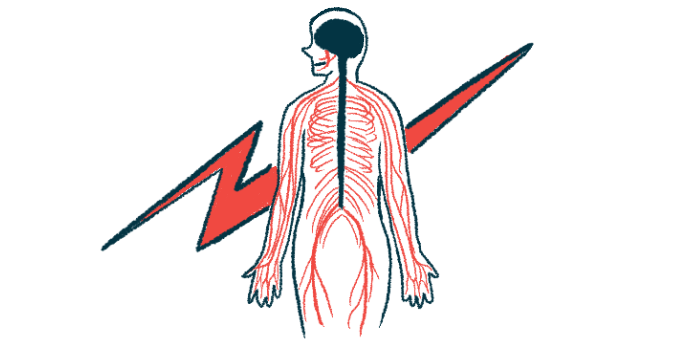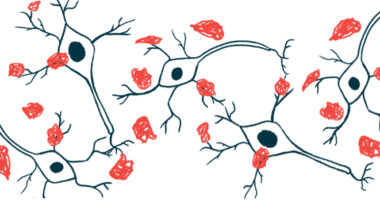Sudoscan skin test may monitor FAP progression: Study
Test could measure progression as well as onset and severity

Sudoscan, a test used to indirectly assess small nerve fiber damage through sweat gland function, may be a marker of disease severity and progression in people with hereditary transthyretin (ATTRv) amyloidosis, a group of diseases that includes familial amyloid polyneuropathy (FAP).
That’s according to a small study in Italy that also showed that electrochemical skin conductance (ESC), a measure of how easily electricity flows through the skin based on sweat production, was an independent predictor of autonomic dysfunction in these patients.
Autonomic dysfunction refers to problems with the autonomic nervous system, which controls involuntary bodily functions like breathing, digestion, and blood pressure regulation.
“Sudoscan may represent a simple and objective measure of autonomic dysfunction in ATTRv amyloidosis, displaying a potential role not only as a measure of both disease onset and severity but also as a marker of disease progression,” the researchers wrote.
The study, “Sudoscan in ATTRv Amyloidosis: A Potential Marker of Disease Progression?,” was published in the journal Neurology and Therapy.
Gene mutations affect nerves
ATTRv amyloidosis refers to a group of conditions caused by mutations in the TTR gene that lead to the formation of toxic clumps of the transthyretin protein in different tissues, affecting their function.
In FAP, toxic transthyretin aggregates accumulate mainly in peripheral nerves, those outside the brain and spinal cord, causing neuropathy, or nerve damage, and neurological symptoms. Patients may also experience autonomic neuropathy symptoms, including digestive, urinary, or blood pressure problems.
When transthyretin clumps build up mainly in the heart, the condition is called ATTRv amyloidosis with cardiomyopathy, and is characterized by heart-related symptoms. When there are both neurological and heart-related symptoms, it is classified as mixed.
Sudoscan is a non-invasive diagnostic tool used to indirectly evaluate small nerve fiber damage and autonomic involvement. It has been shown to have “a high diagnostic accuracy as a screening test in TTR mutation carriers,” the researchers wrote, but “its role as a marker of disease progression is still considered uncertain.”
The team of researchers in Italy assessed changes in sweat gland function over time in 61 people with late-onset ATTRv amyloidosis, in which the disease develops after age 50.
All were followed at the Università Cattolica del Sacro Cuore in Rome between March 2016 and August 2024. Participants had a mean age at study enrollment (baseline) of 68.38. Most (75.4%) were men.
The most commonly reported disease-causing TTR mutation was Val30Met (49.2%), followed by Phe84Leu (31.1%), with other mutations present in lower proportions of patients.
At baseline, 48 patients (78.7%) had mixed ATTRv amyloidosis, nine (14.8%) had FAP, and four (6.6%) had ATTRv amyloidosis with cardiomyopathy. Most (70.5%) had autonomic dysfunction. Of the 57 patients with nerve damage, 70.2% were able to walk without assistance.
About one-third of the patients had been treated for a mean of about two years, with tafamidis as the most common therapy. Tafamidis is approved in the European Union, but not in the U.S., to treat FAP under the brand name Vyndaqel.
During follow-up, participants were evaluated yearly through a neurological examination and with Sudoscan for up to four years. Sudoscan assesses ESC on the feet and hands by sending a tiny, painless electrical current through the skin and measuring how easily the electricity flows; higher ESC indicates better nerve function.
The mean foot ESC significantly decreased from baseline (54 microsiemens [uS]) to the two-year evaluation (36 uS) and three-year evaluation (33 uS). In contrast, there were no significant differences in mean hand ESC, although there was a tendency to decrease over time.
At baseline, lower hand and foot ESC were significantly associated with longer disease duration, higher neuropathy impairment score — indicating worse neuropathy-related disability — and higher Norfolk Quality of Life-Diabetic Neuropathy (QoL-DN) score, reflecting a greater impact of neuropathy on life quality.
Lower hand and foot ESC were also significantly associated with lower scores in the Compound Autonomic Dysfunction Test, reflecting greater autonomic dysfunction.
Statistical analysis shows differences
ESC values were significantly lower in patients with autonomic dysfunction than in those without, both in the feet (35 vs. 73.5 uS) and hands (51 vs. 72 uS). Statistical differences were observed between patients with postural hypotension and those without (feet: 25.5 vs. 65 uS; hands: 36 vs. 66 uS). Postural hypotension refers to a sudden drop in blood pressure when standing from a sitting or lying position.
ESC values were also found to be significantly associated with systolic blood pressure, the blood pressure in the arteries when the heart muscle contracts to pump blood out to the body.
Further statistical analyses showed that feet ESC and the Norfolk QoL-DN score were significant predictors of autonomic dysfunction in these patients. Those with higher ESC values were 4.8% less likely to develop the condition. A foot ESC cut-off value of 57.5 uS allowed researchers to discriminate between patients with or without dysautonomia with an accuracy of 82.6%.
“In addition to a potential role in monitoring disease progression, our findings confirmed the importance of Sudoscan as a marker of disease severity,” the researchers wrote.
The Sudoscan test also “may represent a reliable marker of [autonomic dysfunction] in ATTRv amyloidosis,” the scientists wrote. “It could, therefore, serve as an outcome measure in future clinical trials.”








